
|
xTuple ERP Reference Guide |
To create a new Purchase Order Line Item, select the NEW button. The following screen will appear:
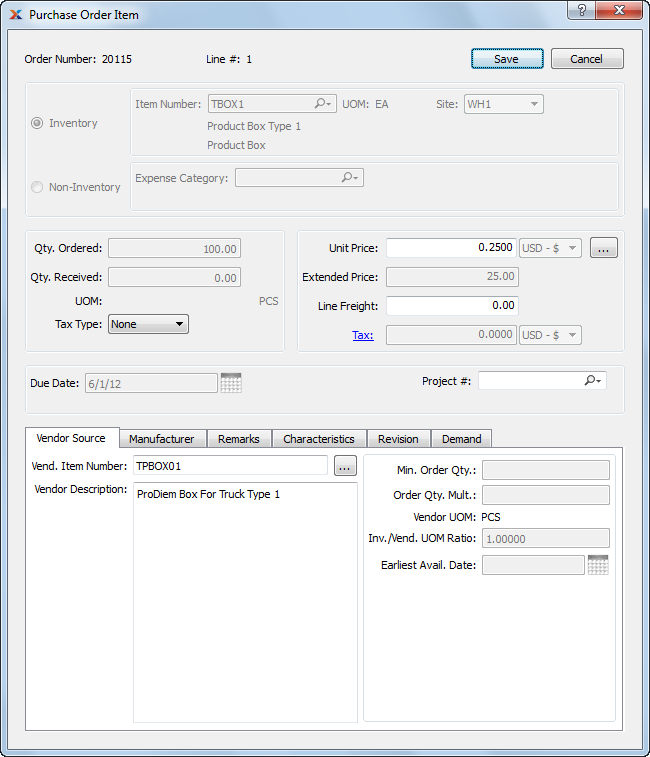
When creating a new Purchase Order Line Item, you are presented with the following options:
If the Line Item was created from a linked Sales Order, the details will be updated whenever the Sales Order is updated.
Displays the Purchase Order Number specified in the "New Purchase Order" screen.
The application automatically assigns line numbers to Purchase Order Line Items. Numbering begins at one ("1") and increases automatically in increments of one.
If the Item being purchased is an Inventory Item, select this option and specify the following:
Enter the Item Number of the Item you want to add to the Purchase Order. You may also enter manufactured Items that you normally make, but you occasionally buy.
Specify the Site the Item will be supplied from. The supplying Site is the Site that supplies the Item in question to the shipping Site for shipment to Customers. Sites may be designated as supplying Sites in the Item Site definition.
The supplying Site may differ from the receiving Site(s) for some Purchase Order Line Items. To update your Inventory records to indicate that Items have been moved from the receiving to the supplied from Site, perform an Inter-Site Transfer.
If the Item being purchased is a non-Inventory Item, select this option and specify the following:
Select an Expense Category to assign the non-Inventory Item to.
Enter the quantity of the specified Item to be ordered.
Displays quantity received from quantity ordered.
Unit of Measure Item is being ordered in.
Select a Tax Type.
Enter the Unit Price for the specified Item—or use the lookup—feature to look up pricing information, including pricing related to quantity breaks.
Displays the Extended Price. The Extended Price for a Line Item is based on the quantity ordered multiplied by the Unit Price.
Enter the amount of freight charges for the entire Line Item quantity. The system automatically calculates the per unit freight charge by dividing the Line Item freight amount by the Line Item quantity. This per unit freight charge is needed when receiving or vouchering quantities less than the original quantity ordered. Line Item freight is distinguished from miscellaneous freight, which applies to the Purchase Order as a whole
Displays the calculated tax amount.
Specify date when Order is expected to be received. For drop ship Orders, the due date for Purchase Order Items will be the same as the linked Sales Order's scheduled date.
If your system is configured to use Projects, select a Project Number to associate with the Purchase Order Line Item. If the Purchase Order Line Item is being created from a Purchase Request driven by Sales Order demand—and the parent Sales Order had a Project Number associated with it—then the Project Number from the parent Sales Order will automatically be entered here. In this way, Sales Orders and Purchase Order Line Items may be linked to the same Project.
When you have the xTuple Project Accounting package installed—and you link a Project to the Purchase Order Line Item—transactions related to the Purchase Order Line Item will include the Project Number as the final segment of affected G/L Account Numbers. Account Numbers related to the following transactions will include Project Number as the final segment: Post Receipt, Correct Receipt, and Post Purchase Order Return. If there are cost variances when vouchering, the Purchase Variance Account will also inherit the Project Number segment.
If Item Source information exists for an Inventory Item, that information will display automatically here. For non-Inventory Items, you should specify an Item Number and Item description.
Enter the Item number the Vendor assigns to the specified Item.
Enter the description the Vendor uses to describe to the specified Item.
For Inventory Items only, displays the minimum order quantity for the specified Item and the specified Vendor. Minimum order quantities are established in the Item Source master.
For Inventory Items only, displays the order multiple for the specified Item and the specified Vendor. Order multiples are established in the Item Source master.
For Inventory Items only, displays the Unit of Measure used by the Vendor for the specified Item.
For Inventory Items only, displays the ratio between Inventory and Vendor Units of Measure.
The Inv./Vendor UOM Ratio specifies the ratio between Inventory and Vendor Units of Measure (UOM). For example, if you store an Item in single units, but a Vendor sells you the Item in cases of 12, then the ratio would be 12—or 12:1. When an Inv./Vend. ratio is specified, the system allows you to purchase Items using the Vendor's UOM; however, when the Items are received, the system will automatically convert the Inventory to your Inventory UOM.
For Inventory Items only, displays the earliest due date for the specified Item.
To add manufacturer information to the Purchase Order Item, select the "Manufacturer" tab. The following screen will appear:
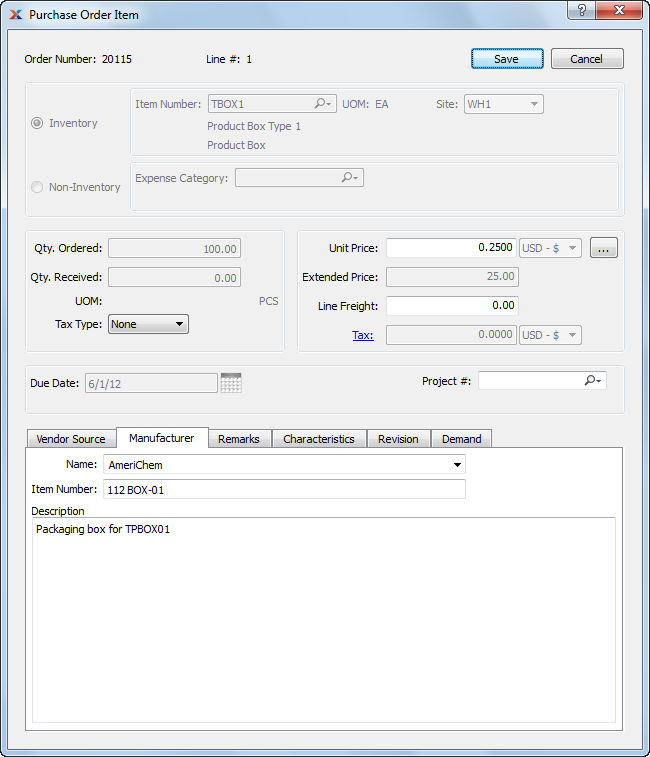
When entering manufacturer information to a Purchase Order Item, you are presented with the following options:
The name of the manufacturer who creates the Item.
The Item Number the manufacturer uses to identify the component.
The Description the manufacturer uses to describe the item.
To add miscellaneous Remarks to the Purchase Order Item, select the "Remarks" tab. The following screen will appear:
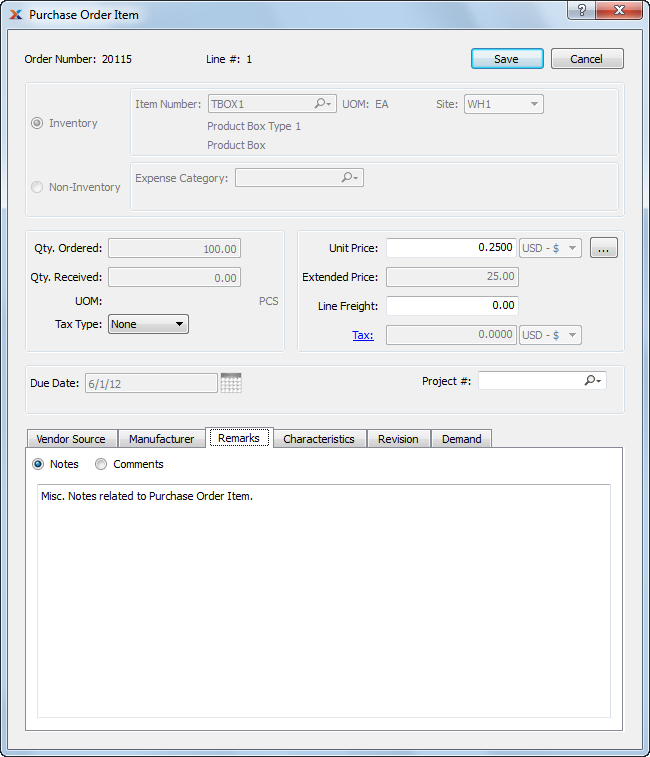
When entering miscellaneous Remarks to a Purchase Order Item, you are presented with the following options:
This is a scrolling text field with word-wrapping for entering Notes related to the Purchase Order Line Item.
To view system-generated Comments associated with an Item—or to add new Comments of your own—select the "Comments" option.
If an Item has Characteristics associated with it, you have the option of linking those Characteristics to a Purchase Order Item. In the case where Sales Order demand generates a Purchase Request, Item Characteristics and Values inherited from the Sales Order will already be linked to the Purchase Order. Ultimately, Characteristics associated with a Purchase Order Item may be printed on the Purchase Order report.
You can link Characteristics and Values to an Item by using the Item master. Once entered, these Characteristics and Values will be available to users entering Purchase Order Items.
To specify or edit Characteristics for a Purchase Order Item, select the "Characteristics" tab at the bottom of the screen. The following screen will appear:

When selecting or editing Characteristics for a Purchase Order Line Item, you are presented with the following options:
Displays the name of any Item Characteristics associated with the Item. Characteristics defined as Item Characteristics may be associated with Items on the Item master.
Displays the default Value associated with an Item Characteristic, but permits you to specify an alternate Value. When associating Characteristic Values with a Purchase Order Item, you have four options: 1) Select the default Value; 2) select an alternate pre-defined Value; 3) manually enter a new Value in place of the pre-defined Value; or 4) make no selection. Making no selection means the Characteristics will not be associated with the Purchase Order Item—except in the case of Characteristics inherited from Sales Orders, by way of Purchase Requests.
When ordering purchased Items, you have the option to specify which Revision of the Item's Bill of Materials and Bill of Operations you want to buy. By default, the active Revision will be used. To specify Revision information for a Purchase Order Item, select the "Revision" tab. The following screen will appear:
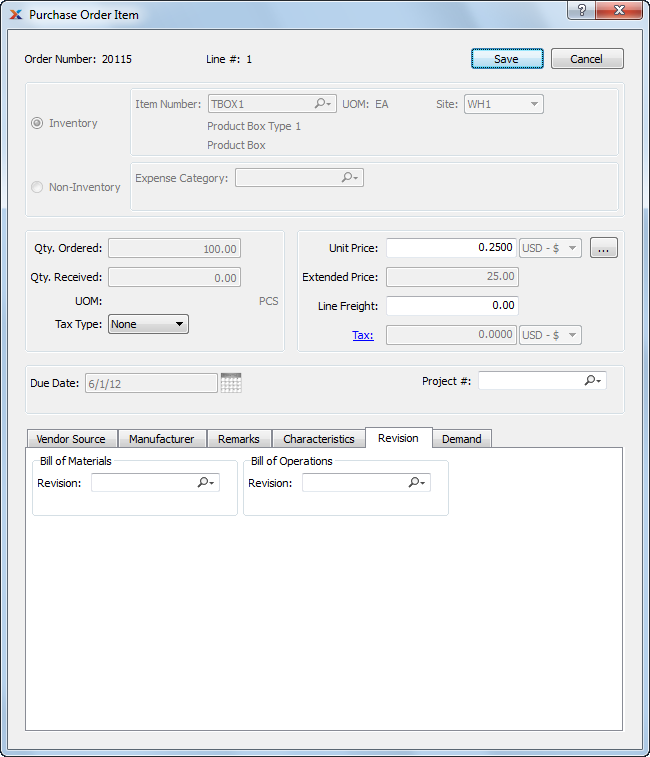
You may create Purchase Order Items for pending Revisions. For Purchase Order purposes, a pending Revision is considered to be the same as an inactive Revision. The Revision status of a pending Revision will not be changed if a Purchase Order Item is created for it.
When specifying Revision information for a Purchase Order Item, you are presented with the following options:
Specify the BOM Revision you want to use for the Purchase Order Item. By default, the active Revision will be used.
Select from the list of existing available Revisions. The status of the Revision will also be displayed.
Specify the BOO Revision you want to use for the Purchase Order Item. By default, the active Revision will be used.
Select from the list of existing available Revisions. The status of the Revision will also be displayed.
To view demand information for Purchase Order Items linked to Sales Orders or Work Orders, select the "Demand" tab. The following screen will appear:
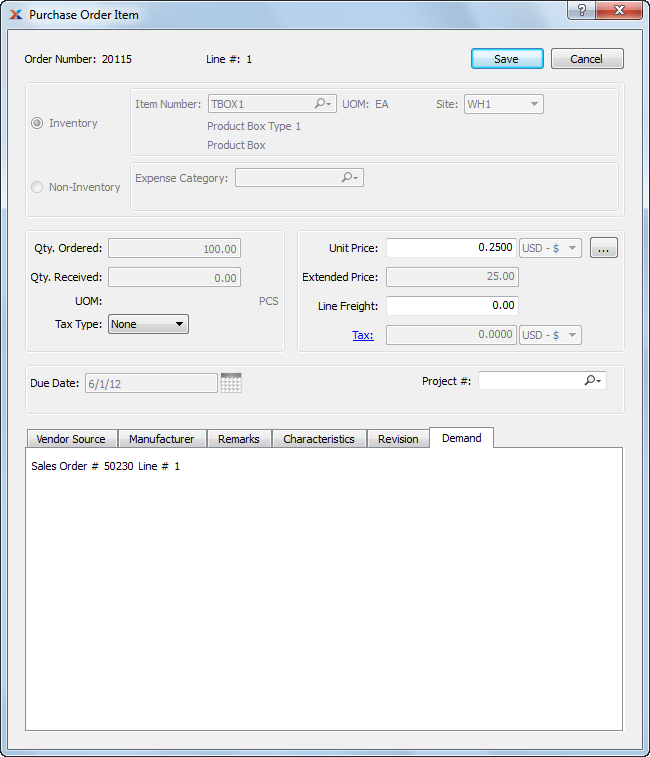
Displays information about the Sales Order or the Work Order the Purchase Order Item is linked to. If the Purchase Order Item is not linked, the "Demand" tab will be disabled.